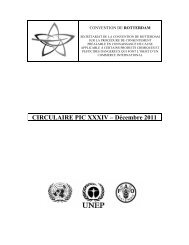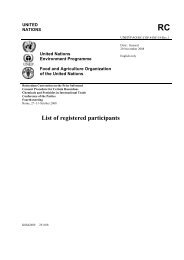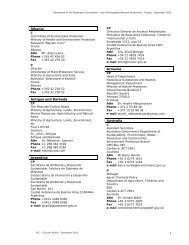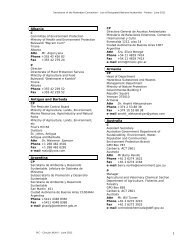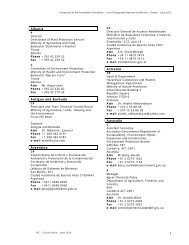RC - What is RC? - Rotterdam Convention
RC - What is RC? - Rotterdam Convention
RC - What is RC? - Rotterdam Convention
You also want an ePaper? Increase the reach of your titles
YUMPU automatically turns print PDFs into web optimized ePapers that Google loves.
a<br />
particulate matter.<br />
Considering the vapour pressure of the compound, i.e. 20 Pa at<br />
20 °C (McConnell et al., 1975), transfer across soil-air<br />
boundaries may be significant. Depending on the soil type,<br />
adsorption will hinder th<strong>is</strong> transport (see below). In a field study<br />
in the ex-USSR, concentrations of hexachlorobutadiene in air above<br />
vineyard were found to be 0.08 and 0.003 mg/m 3 at 1 day and 3<br />
months, respectively, following a spring application of 250 kg/ha.<br />
The method of analys<strong>is</strong> was not reported. Volatilization of the<br />
compound from light soils was more rapid than from heavy soils<br />
(Litvinov & Gorenshtein, 1982).<br />
The Henry coefficient of hexachlorobutadiene <strong>is</strong> 0.43 (1040<br />
Pa.m 3 .mol -1 ) at 25 °C (Shen, 1982) and 0.3 at 22 °C Hellmann,<br />
1987a). These values are comparable to those of other chlorinated<br />
aliphatic alkenes. They indicate possible transfer of the compound<br />
across water-air boundaries leading to a wide d<strong>is</strong>tribution, with<br />
aerial transport playing a major role (McConnell et al., 1975). In<br />
a model experiment, hexachlorobutadiene was allowed to evaporate<br />
from a 20-mg/litre aqueous-methanolic solution, containing 10%<br />
methanol, in a porcelain basin with slow magnetic stirring at 22 °C.<br />
UV spectrophotometry recorded a 25% loss within 28 min. It was<br />
shown<br />
that methanol decreased the d<strong>is</strong>appearance time. For the transfer of<br />
th<strong>is</strong> and other model results to flowing waters, a reduction factor<br />
of 30 was proposed for the rate of evaporation on the bas<strong>is</strong> of<br />
limited data for two compounds (Hellmann, 1987a).<br />
2<br />
In a model experiment, UV spectrophotometric analys<strong>is</strong> of<br />
solutions of hexachlorobutadiene in deionized water to which<br />
1 g/litre of clay mineral (Fuller's earth) was added revealed a<br />
clay-water partition coefficient of 500 litre/kg, showing limited<br />
adsorption to pure clay minerals comparable to that of other<br />
chlorinated alkenes (Hellmann, 1987b). Based on the log<br />
octanol-water partition coefficient (log Kow) of 4.78-4.90<br />
(Table 1), hexa-chlorobutadiene <strong>is</strong> expected to adsorb strongly to<br />
organic matter. The organic carbon-water partition coefficient<br />
(Koc) can be estimated to be 25 120 litre/kg on the bas<strong>is</strong> of a log<br />
Kow of 4.8 using the semi-empirical equation of Karickhoff (1981).<br />
Oliver & Charlton (1984) determined a Koc value of 158 500<br />
litre/kg on the bas<strong>is</strong> of sediment and water concentrations in the<br />
Niagara River, USA. Partition coefficients of approximately<br />
200-260 litre/kg were found for two unspecified types of soil in<br />
model experiments employing gas chromatographic analys<strong>is</strong> of<br />
solutions of hexa-chlorobutadiene in water (Leeuwangh et al.,<br />
1975; Laseter et al., 1976). In field experiments conducted along<br />
the M<strong>is</strong>s<strong>is</strong>sippi river in the USA in 1974-1975, some water samples<br />
were found to contain 1.0-1.5 µg/litre, whereas levee soil samples<br />
at the same sites contained 62-1001 µg/kg dry weight. At a more<br />
polluted site near a Hex-waste landfill, water samples contained<br />
0.04-4.6 µg/litre and mud samples 270-2370 µg/kg dry weight. These<br />
studies show that soil-water partition coefficients can range over<br />
to 4 orders of magnitude assuming equilibrium (Laseter et al.,



